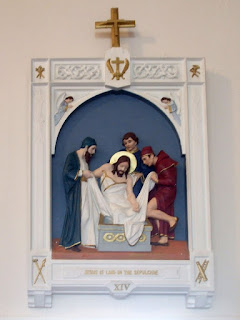Many years passed before there was a resident priest. By 1847, the congregation had grown so large that Redemptorist priests replaced the chapel with a larger frame church and dedicated it under the title of St. Mary Parish. The Bondy family donated land to be used as a cemetery six years later.
.

The parish continued to grow and decided to move in 1873 and, three years later, the church was moved to Rockwood to be near an interstate railroad as well as the river. In 1880, Stephen Mannausa donated land for a new church. The frame church was torn down and a brick church, with a capacity for 400, was dedicated on July 11 of that year. The church was built at a cost of $5,000 (~$110,000 after inflation), a rectory for $3,000 (~$67,000), as well as a carriage shed.
Fr. John Helton became the first resident pastor in 1899 and was succeeded by Fr. Toussaint Rose four years later. A large fire soon caused extensive damage to the church. The parish decided to tear down the damaged church and replace it with a larger one in 1911. However, many of the stained-glass windows were recovered and some of the bricks were reused in the new belltower.
IHM Sisters from Monroe began teaching weekly catechism classes. Construction of a parish school began in 1929 and the school opened in September of 1930 under the direction of Sisters of St. Francis from Rochester, Minnesota.

Fr. Archibald Soest was appointed pastor in 1934 and guided the parish through the financial problems of the Great Depression. Fr. Gerald LeVasseur became pastor and Adrian Dominicans replaced the Sisters of St. Francis at the school. Enrollment grew rapidly in the 1960s and an extension was built, allowing twice as many classrooms.
Fr. Francis Zarrett served 1966-1969 until he was replaced by Fr. Thomas Sauter. Fr. Sauter soon realized that the parish had a $800,000 debt and there was a possibility that the school would be closed. A partnership with the public schools allowed St. Mary School to stay viable for 15 years until state Supreme Court ruled it to be unconstitutional. A “Save Our School” campaign raised enough money to make the parish and school solvent.
Fr. Sauter retired in 2002, after 33 years as pastor, and was replaced by Fr. Marc Gawronski. Fr. Sauter eventually passed away on March 20, 2004. The following year, Fr. James Rafferty began his first assignment as pastor and remains there today.


In the last 15 years, St. Mary's has seen many renovations such as new altar rails, a wheelchair ramp, new stained-glass windows, repainting walls and refurbishing floors and stairs. Some of the windows (below) have been reused to make Christmas ornaments and jewelry.


St. Mary later clustered with St. Victor Parish (est. 1963) in Gibraltar. In 2013, the two parishes merged to form St. Mary, Our Lady of the Annunciation Parish and St. Victor Church closed.


The parish's Changing Lives Together campaign raised enough money to continue future enhancements such as a narthex, restrooms, kitchen, and meeting space.
New murals in the transepts and above the side altars.


St. Michael the Archangel in one of the nave windows; two separate transept windows show the Annunciation.
An inscription from John 1:14 frames the sanctuary and translates “And the Word was made flesh, and dwelt among us.” A monstrance is shown at the apex of this arch.

The church does not have a freestanding altar and all Masses are offered ad orientem. Not surprisingly then, Holy Communion is often administered at the altar rail with a paten.
Detail of the altar rail; a shrine to the Sacred Heart of Jesus
Our Lady of Fatima in the south transept; the Coronation of the Blessed Virgin in the north transept.
Arched, stained-glass windows in the nave; each window includes a Marian symbol with an 'M' and a crown. From left: St. Jude, St. Therese, St. Faustina and Blessed Margaret of Castello.
Moses is depicted beneath the stairs to the choir loft; a Divine Mercy window overlooks the choir loft


For more photos: AOD Film Services
For more info: parish website + bulletin archive














































